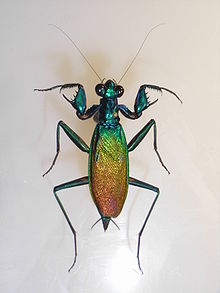| Metallyticus | |
|---|---|

| |
| Metallyticus splendidus | |
| Scientific classification | |
| Domain: | Eukaryota |
| Kingdom: | Animalia |
| Phylum: | Arthropoda |
| Class: | Insecta |
| Order: | Mantodea |
| Family: | Metallyticidae Handlirsch, 1925 |
| Genus: | Metallyticus Westwood, 1835 |
| Species | |
| Synonyms | |
| |
Metallyticus is a genus of praying mantis. It is the only genus in the monotypic family Metallyticidae. They are mostly found in South-East Asia. The species of the genus are dark, somewhat flattened and cockroach-like, and often with a cuticle that is reflective and metallic in appearance.[1][2]
The phylogenetic position of Metallyticidae relative to other mantis families has been studied using both morphological and molecular characters, but consensus on its placement has not been achieved.[3] Along with the genera Chaeteessa and Mantoida, Metallyticus is considered a member of the basal Mantodea,[3] though some scientists consider the application of this term to extant species to be misleading.[4] Metallyticidae species have several autapomorphic traits, including their metallic coloration and the enlarged spine on their front legs. They also have many plesiomorphic traits, including a relatively short pronotum and full wings in both sexes.[3]
Of the five species, M. splendidus and M. violaceus are the most abundant. Most specimens for scientific study have been found in Sumatra, Borneo, Java, and the Malay Peninsula.[3]
Species in this family are distinct from other mantises in their method of prey capture; Metallyticus species typically dart to capture prey, remaining close to the ground, rather than waiting to ambush. These species are usually found in or under bark of decaying trees.[3]
Species
[edit]- Metallyticus fallax Giglio-Tos, 1917
- Metallyticus pallipes Giglio-Tos, 1917
- Metallyticus semiaeneus Westwood, 1889
- Metallyticus splendidus Westwood, 1835
- Metallyticus violaceus (Burmeister, 1838)
References
[edit]- ^ "genus Metallyticus Westwood, 1835: Mantodea Species File". mantodea.speciesfile.org. Retrieved 2021-02-01.
- ^ "Metallyticus". tolweb.org. Retrieved 2021-02-01.
- ^ a b c d e Wieland, Frank (2008). "The genus Metallyticus reviewed (Insecta:Mantodea)" (PDF). Species, Phylogeny and Evolution. 1: 147–170.
- ^ Krell, Frank T.; Cranston, Peter S. (2004). "Which side of the tree is more basal?". Systematic Entomology. 29 (3): 279–281. doi:10.1111/j.0307-6970.2004.00262.x
External links
[edit] Media related to Metallyticus at Wikimedia Commons
Media related to Metallyticus at Wikimedia Commons- Tree of Life - Metallyticidae
- Mantodea Species File (Version 5.0/5.0)
Well, that’s interesting to know that Psilotum nudum are known as whisk ferns. Psilotum nudum is the commoner species of the two. While the P. flaccidum is a rare species and is found in the tropical islands. Both the species are usually epiphytic in habit and grow upon tree ferns. These species may also be terrestrial and grow in humus or in the crevices of the rocks.
View the detailed Guide of Psilotum nudum: Detailed Study Of Psilotum Nudum (Whisk Fern), Classification, Anatomy, Reproduction